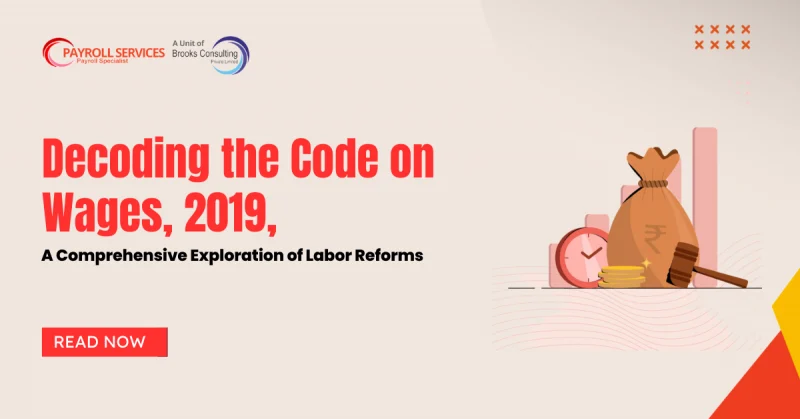Decoding the Code on Wages, 2019, A Comprehensive Exploration of Labor Reforms
The Ministry of Labour and Employment in India is embarking on a monumental task — consolidating over 100 state laws and 40 central laws governing labor into four new codes. One of these transformative codes is the Code on Wages, 2019, which seeks to bring about universalization and regulation of minimum wages for employees in both organized and unorganized sectors.
Why a New Code on Wages?
A staggering 80% of India’s workforce, roughly 300 million workers, currently lack coverage under any social security measures. Despite existing rules regarding minimum wages, bonus eligibility, and pay equality, a significant portion of the unorganized sector remains excluded. To address this disparity, combat employee exploitation, and streamline diverse regional labor laws, the Ministry of Labour and Employment proposes the Code on Wages.
Having received approval from both houses of parliament, the Code on Wages, 2019 is currently in the draft stage, poised for implementation. This transformative legislation aims to simplify four existing regulations: the Payment of Wages Act, 1936; the Minimum Wages Act, 1948; the Payment of Bonus Act, 1965; and the Equal Remuneration Act, 1976.
Understanding the New Wage Definition
At the core of the Code on Wages lies a redefined concept of wages. This new definition classifies wages into three categories: inclusions, exclusions, and conditions governing the exclusions. Basic pay, dearness allowance, and retaining allowance (in some cases) fall under inclusions, while exclusions encompass various components such as statutory bonus, employer’s contribution to provident fund, conveyance allowance, and more.
A crucial condition stipulates that these exclusions should not contribute more than 50% of the overall remuneration. If they do, the exceeding amount is treated as wages. This safeguard ensures that companies do not manipulate wages by increasing allowances.
Key Definitions Under the Code on Wages
Understanding the code necessitates familiarity with key terms:
- Establishment: Encompasses any place where industry, business, trade, occupation, or manufacturing is conducted, including government organizations.
- Employer: Any entity with ultimate control over work within an establishment, including delegated authorities like managers or managing directors overseeing operations.
- Employee and Worker: Encompasses individuals engaged in various types of work, with exclusions for apprentices and members of the armed forces.
- Contractors: Individuals engaged by an establishment to deliver specific results, including sub-contractors.
Proposed Changes to Existing Regulations
The Minimum Wages Act
- Applicability: Expanded to cover all types of employment, not restricted to scheduled employment.
- Working Hours: Explicitly mentions breaks within the total 9-hour work period.
- Criteria for Determining Minimum Wage: Considers contextual factors like skill set, geography, and working environment.
- Overtime Wage Rules: Overtime wages cannot be less than twice the normal wage.
- National Floor Wages: Central government revisits the national floor rate, while state governments set minimum floor rates, not less than the minimum wage.
The Payment of Bonus Act
- Applicability: Applies to establishments with 20 or more employees, with no changes to minimum and maximum bonus rates.
- Bonus Limit: Bonus amount paid should exceed the minimum wage, floor rate, or wage ceiling for the state.
The Equal Remuneration Act
- Applicability: Applies universally, preventing gender-based discrimination in employment terms.
The Payment of Wages Act
- Applicability: Covers all establishments under existing industries and factories legislation.
- Wage Payment Deadlines: Stringent timelines for salary payments based on employment type, with a new deadline for monthly wage workers.
- Final Settlement: Mandates settlement within 2 days of employment termination.
Employer’s Liabilities
Employers bear responsibilities such as correct payment of minimum and overtime wages, compliance with work hour regulations, electronic or record book maintenance of employee registers, and providing detailed pay slips. Failure to comply results in penalties ranging from fines to imprisonment.
Impact of Non-Compliance
Offenses related to wage discrepancies and other code violations incur fines and, for repeated breaches, potential imprisonment.
Glossary
To facilitate understanding, a glossary is provided, defining terms like organized and unorganized sectors, gazette, gazetted officer, and article of manufacture.
As India progresses towards a revamped labor framework, decoding the intricate provisions of the Code on Wages becomes imperative. This comprehensive guide navigates the proposed changes, ensuring clarity for both employers and employees in the dynamic landscape of Indian labor laws.

